Load-In/Load-Out Artist Share Their Tips and Tricks
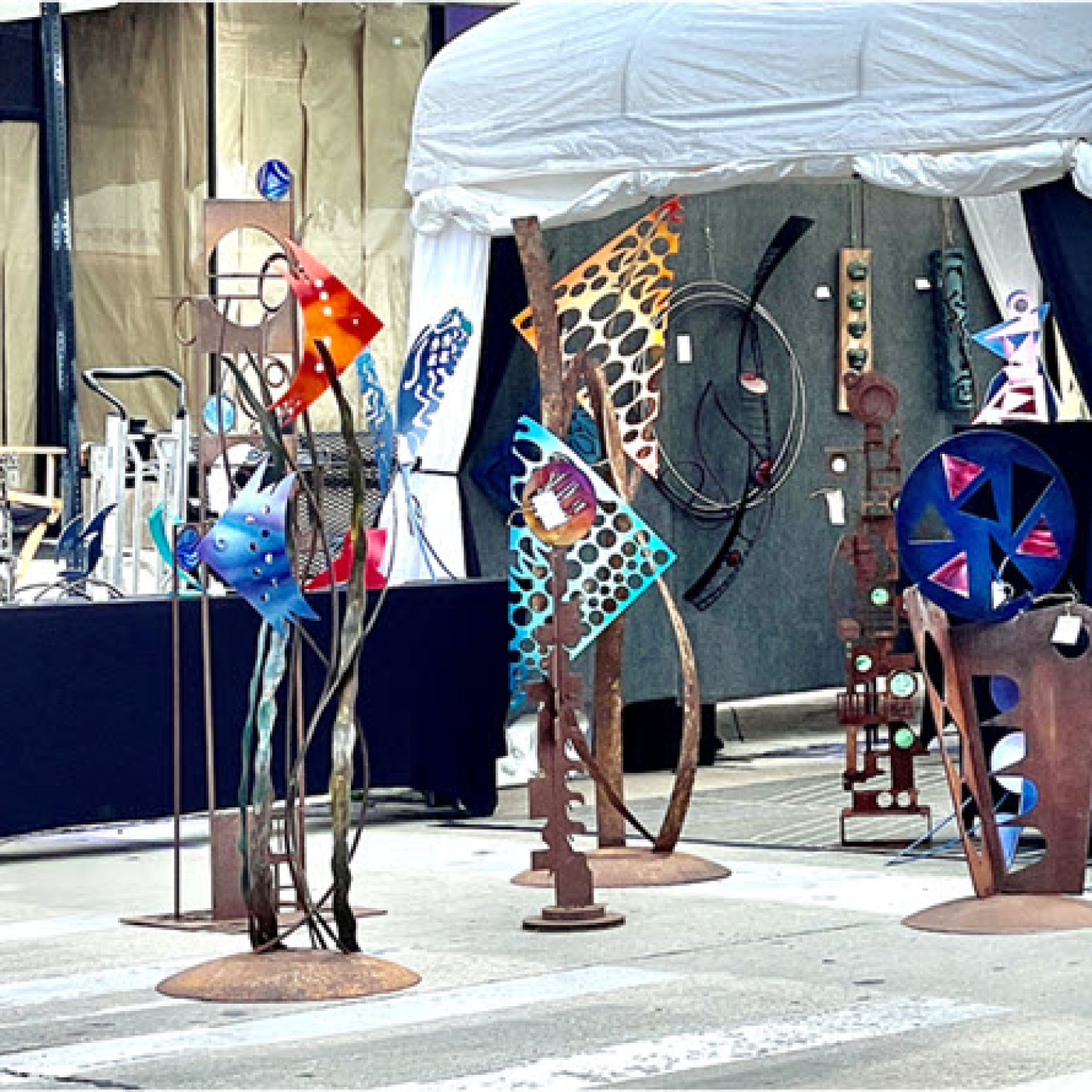
Fiber artist Jahna Kahrhoff makes sure she has everything needed for a show by printing a packing list for it. Each type of event — indoor show, outdoor show, event without electricity — has its own list.
“I know exactly where everything goes in my car and in what order to put things in and take them out, so everything fits,” Kahrhoff said. “I use every space available, including a hidden compartment in the floor of the hatch, the spaces behind the driver and passenger seats, etc.”
She is among the artists who responded to a recent Sunshine Artist survey about load-in/-out. Mixed/fiber artist Rebecca Szabo also shared tips for making the process easier. “We have a checklist for each event — all racks, tables, etc. are stored together in the garage, and inventory and small display pieces are in the house for easy access,” she said. “We try to assemble the items at least a day in advance so we are not rushed the morning of load-in, especially if we are traveling a few hours away.”
Szabo said they try to load their truck with the racks and tables on top since they must be up first, and she reminded artists to make sure their table covers and drapes are not buried. “We also keep lights and power cords in a separate bin, as we don’t need them at every show,” she said.
Kelly O’Neill, a metal and ceramic sculpture artist, recommends taking an inventory of the artwork before the show and then packaging and boxing it based on the show’s layout. “This extra organizational step saves you time when setting up your art,” O’Neill said. “Second, create a complete check sheet that covers everything you need to load. I organize it by category: tent and display supplies, merchandising and sales items, toolbox, and art.”
She said her last step is to preload everything into a staging area and then load the vehicle, knowing what she puts in first is needed last. “After the show, I update the check sheet to reflect any changes. For example, I no longer need the square tile charged since I take payment using tap technology,” O’Neill said. “This over-planning may seem excessive to some, but it helps reduce stress and makes room in my brain for other things that day.”
Photographer Jay Waters also thinks about the order in which he needs what is in his vehicle. “I try to have the things I need first on top, so I can just handle them once as I set up (when I get to keep my SUV next to my space during setup). Also, I try to be ruthless about not packing things I don’t need,” he said. “When I first started, I was sloppy about packing things that I didn’t need, that just contributed to clutter. Third thing, I subdivide everything as much as possible, using plastic shoebox containers and Ziplocs.”
Waters has a separate Ziploc bag for the bungees and clips he uses for his booth sign, one for the bungees he uses for his grid, and then another for the tent. “Have a checklist that you can keep handy as you’re packing up at home to make sure you haven’t missed anything. For instance, I have a tablecloth that I put on a table in my booth that I wash when I get home from a show. Without a checklist, that is something that might not make it back downstairs from the laundry,” he said.
Ceramicist S. Jackman likes a checklist as well and said, “Putting it in a simple spreadsheet means you can print and reuse it. If you realize you forgot something, add it to your printout, and add it to your electronic copy when you get home.”
Wendy Converse, a ceramic sculpture artist, makes sure the tent and weights are easy to access. “The quicker you can set up your tent, the sooner your booth can come together,” she said.
Christine Wright, a bead weaving jewelry artist, said, “Don’t have a vehicle that’s ‘just right.’ Make sure you can pack with a little breathing room. Pay attention to weight. It’s unsafe to drive with too much weight on one side. It’s best to keep the heaviest stuff near the center and middle (not back) of the vehicle. Tie down or secure larger, heavier things that might move around when driving.”
David Baldwin puts his paintings (acrylic on canvas) in bubble sleeves. He said that keeps them safe and makes it easy to move the pieces. “We try and put things back in order and grouped — canopy parts, legs, etc. — so we aren’t rooting for them,” Baldwin said.
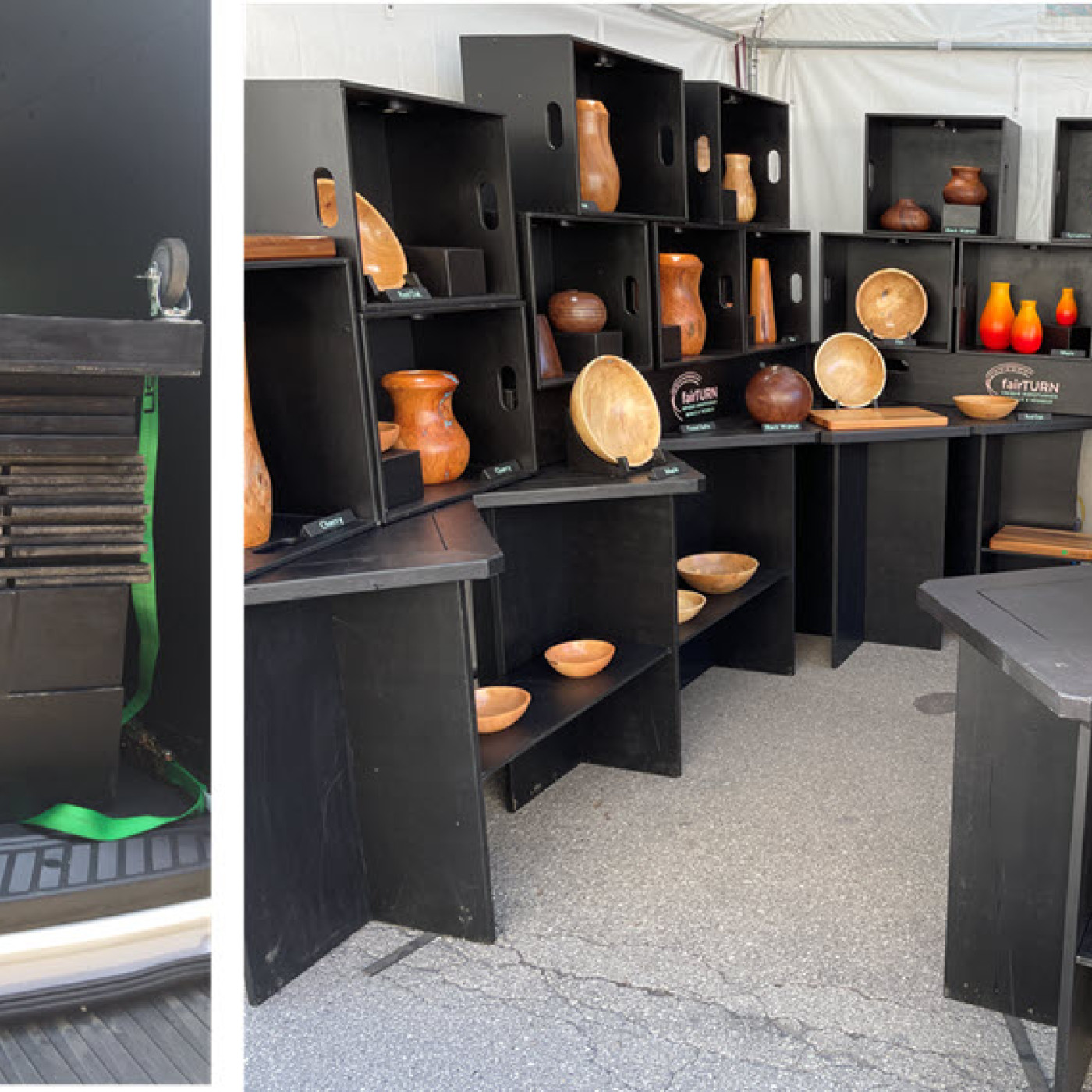
Wood artist Mark Hilligoss uses tables and tops that lie flat in a cubic modular design, which makes packing uniform in his van. “Most of my work is then packed in wooden rectangular boxes, which double as display cases,” he said. “This way, cargo straps in the van are most effective controlling the load since everything stacks squarely.”
Amy Parker, a jewelry artist, takes pictures of her fully loaded vehicle from all sides, so she knows how to pack everything back into it. “If I don’t, I forget which tables have to go at what angle, and then the whole thing is off,” she said.
Clay artist Barb Cara puts her weights on the floor behind the seats, with her tables and shelves covering the gap between her vehicle’s front and back seats, which are laid flat. She packs her pottery in plastic bins she can easily lift. “The extras — like straps, tools, and clamps — are packed in a smaller tote so everything I need for setup is in one place,” Cara said. “Everything is packed so that nothing slides forward if fast braking is needed. My foldable cart goes in last.”
Her advice includes bringing small pieces of wood to level table legs, charging battery backups and the card charger before the shows, and bringing a second pair of sneakers and socks to change into when wet grass results in wet feet. “Have at least 60 pounds of weight on each tent leg. Thank your security and show helpers,” Cara said.
From Vehicle to Booth
When artists are unable to drive right up to their booths, some use a dolly to transport everything from their vehicle to their space. Wright said invest in a good one.
Tonya Cameron’s medium is painting/acrylic, and she uses a wagon to get everything from her vehicle to her booth. She said it folds up and holds quite a bit. “It’s not perfect, but it works,” Cameron said.
Szabo said a collapsible wagon or two are must-haves. “Use bungees to secure the load in case of ramps or potholes,” she said.
Baldwin uses a cart and said, “We have it down where our rolling cart can clear the booth in three trips.”
Jackman has a folding dolly and said the ones sold for transporting musical instruments are good, as they have vertical support at both ends and fold quite flat.
Metal sculpture artist Mark Zirinsky has two dollies and moves the tent, lights, and backdrops first, followed by his artwork.
Converse said a quality, appropriately sized dolly is necessary. “Know what you need to move and how to group to keep a minimum of trips, while not weighing a ton,” she said. “Spend the money on larger tires, which can easily navigate any surface or bumps. Bungee cords also help.”
Metal sculpture artists Jerry and Jacque Crable see artists using carts or wagons that have tiny wheels and said, “Take the time to replace those wheels with larger ones. It may cost some money, but the ease in moving over potholes, rocky ground, or grass will be worth it.”
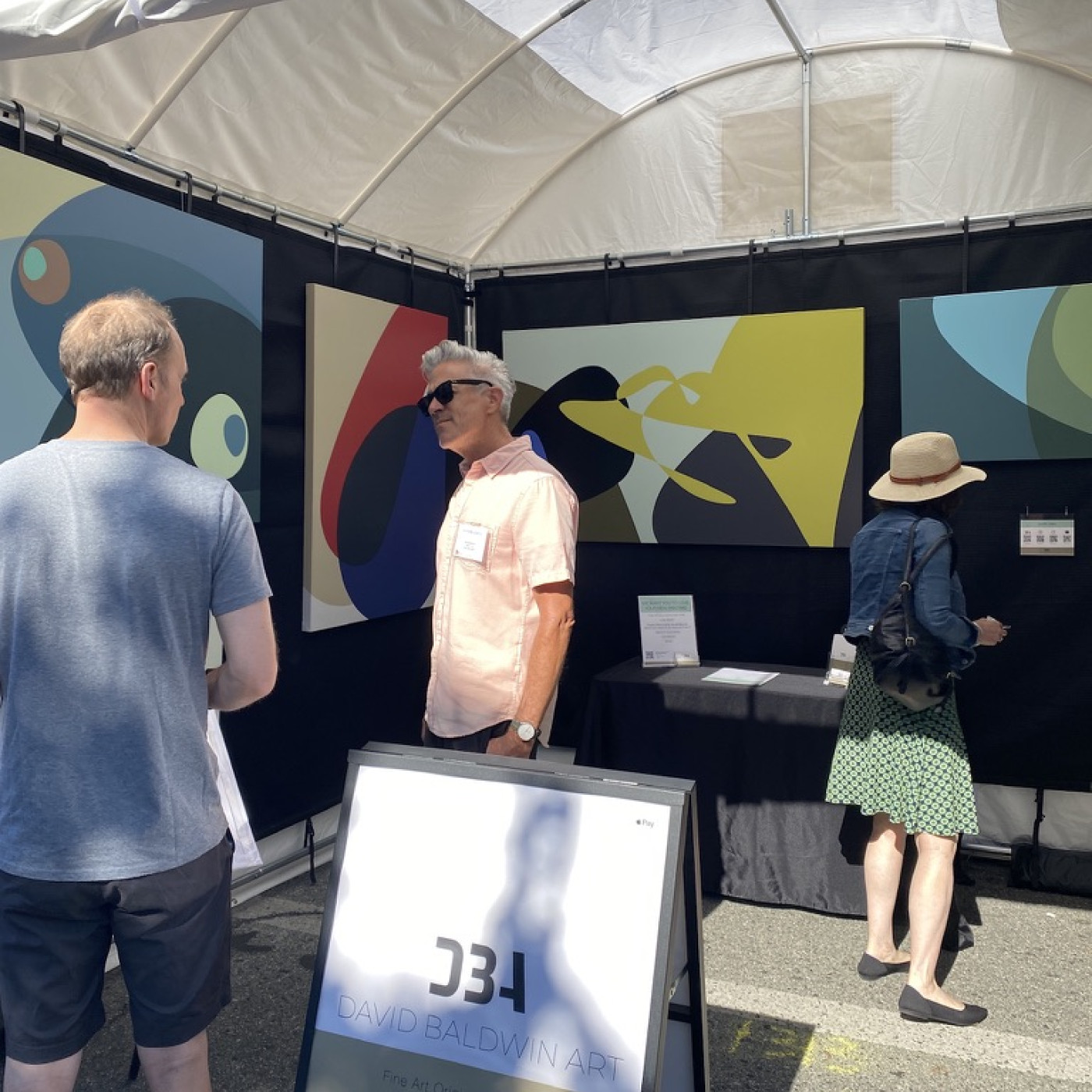
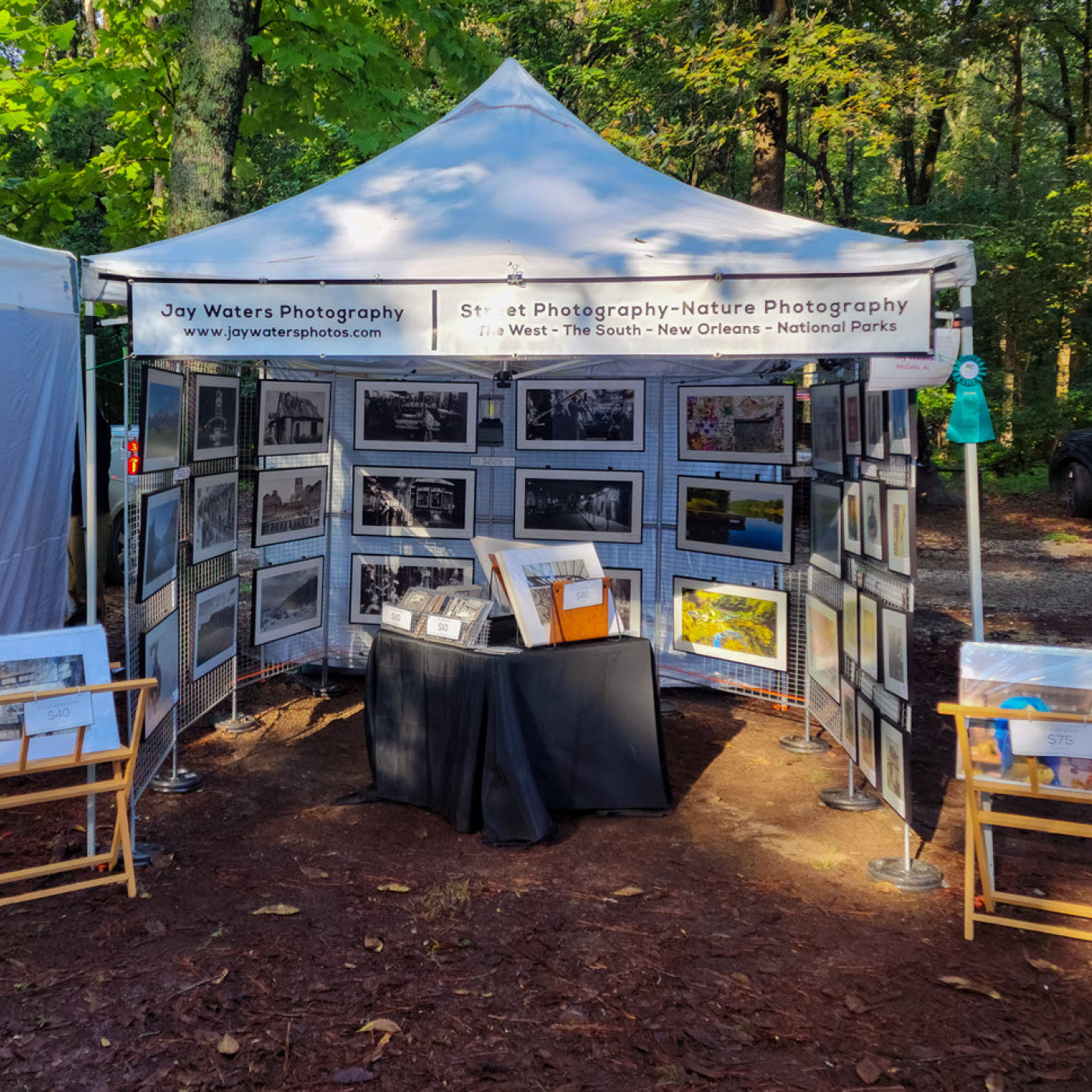
What Works Best
Which procedures make load-in and load-out run smoothly? Artists overwhelmingly prefer staggered arrival times and the ability to drive right up to their booths.
Cameron has had timed arrivals and a big window. She prefers a big window of time, saying, “If I am driving from out of town and it is a long drive, it puts extra pressure to arrive at a certain time.”
Jewelry artist Amy Kelsey said the procedure matters. “It’s all about being a good human and keeping other people in consideration. If you can drive up to your booth, fantastic,” she said. “Don’t open all the doors and unload with your door hanging into the driveway or street. Don’t chat around with your neighbors. Don’t put up your tent until your vehicle is removed from the street — basically commonsense stuff here, but I’m constantly surprised.”
Baldwin prefers a staggered arrival and the ability to drive up to the booth. “Artists are usually very kind and help each other,” he said. “We choose not to do morning setups — just too much work in a short amount of time in the dark.”
Kahrhoff also said staggered arrival times and being able to drive up to the booth are best. “But even if that is not possible, having a plan is really important. It’s important to know what to expect when you arrive, where to go, where to park, etc.,” she said. “Shows that don’t have any instructions for load-in/-out get really confusing. Also, when show organizers don’t follow or enforce their plan, that is very frustrating as well.”
Fused glass artist Emily Ohland said scheduled, staggered arrival times, enforcement of unloading time limits by organizers, assistance for unloading, and the ability to unload at or near the booth site make load-in work best.
Zirinsky said it helps when a show’s staff directs traffic — especially if there is a single-point bottleneck where one poorly placed vehicle can stop the entire process. Before the artists arrive, the electrical, food, and portable restrooms should either be completed or staged, he said. When it is time to tear down, portable restrooms should be removed the next day, if traffic permits.
And Zirinsky said offering tent teardown the day after the show ends is a great option. “For example, at La Quinta, almost one-third of the artists will tear down the morning of the next day following the show, Monday,” he said. “It works if the show is in a park — not so well if the street needs to be reopened to traffic. Of course, where there is limited parking, artists should not get their vehicles until their tent is down and packed.”
Glass mosaics artist Mary Prescott said if a show has volunteers to assist, knowing so ahead of time and being able to schedule it helps. She appreciates shows that have volunteers who are knowledgeable about times, parking, and restrooms.
Converse suggests promoters not bring an entire section in at once. “Instead, bring every third booth, so there is ample space to maneuver and park between booths before the next group arrives. Let vehicles stay long enough to get their tents raised. It is so much more efficient to unload under a tent versus having to unload onto a curb, then move everything a second time once the booth is up, or worse yet to unload everything into your space and then try to set up your tent around it all,” she said. “Provide at least a foot between booths. It is very hard to raise and lower tent sides and even just maneuver when your displays literally touch your neighbors. Not all artists need the same amount of time to set up. Ask in advance and schedule appropriately.”
Parker said the best load-in/-out procedure she experienced was at a fall festival in Duluth, Georgia. The setup was Friday afternoon after school was out, with high school students receiving service credits for working at the festival. Six to eight students moved everything from Parker’s vehicle to her space in about five minutes.
The festival had remote vendor parking, but there were golf cart shuttles steadily going back and forth from the parking lot to vendors’ spaces, she said. “At load-out, you get a slip signed that you have all your stuff packed and ready to load, and then you can bring your vehicle into where you unloaded, and again, six to eight high school students will move it all to your vehicle,” Parker said. “The trick is to have them move in the order you need to load it, of course, but they hang around while you pack it all in.”
Michelle Neathery makes candles and bath and body products. She said it helps when artists wait until they are fully packed before bringing in their vehicle. “If they aren’t packed, they shouldn’t be let in to pull up to their booth,” Neathery said. “It saves so much congestion and makes things go so much smoother.”
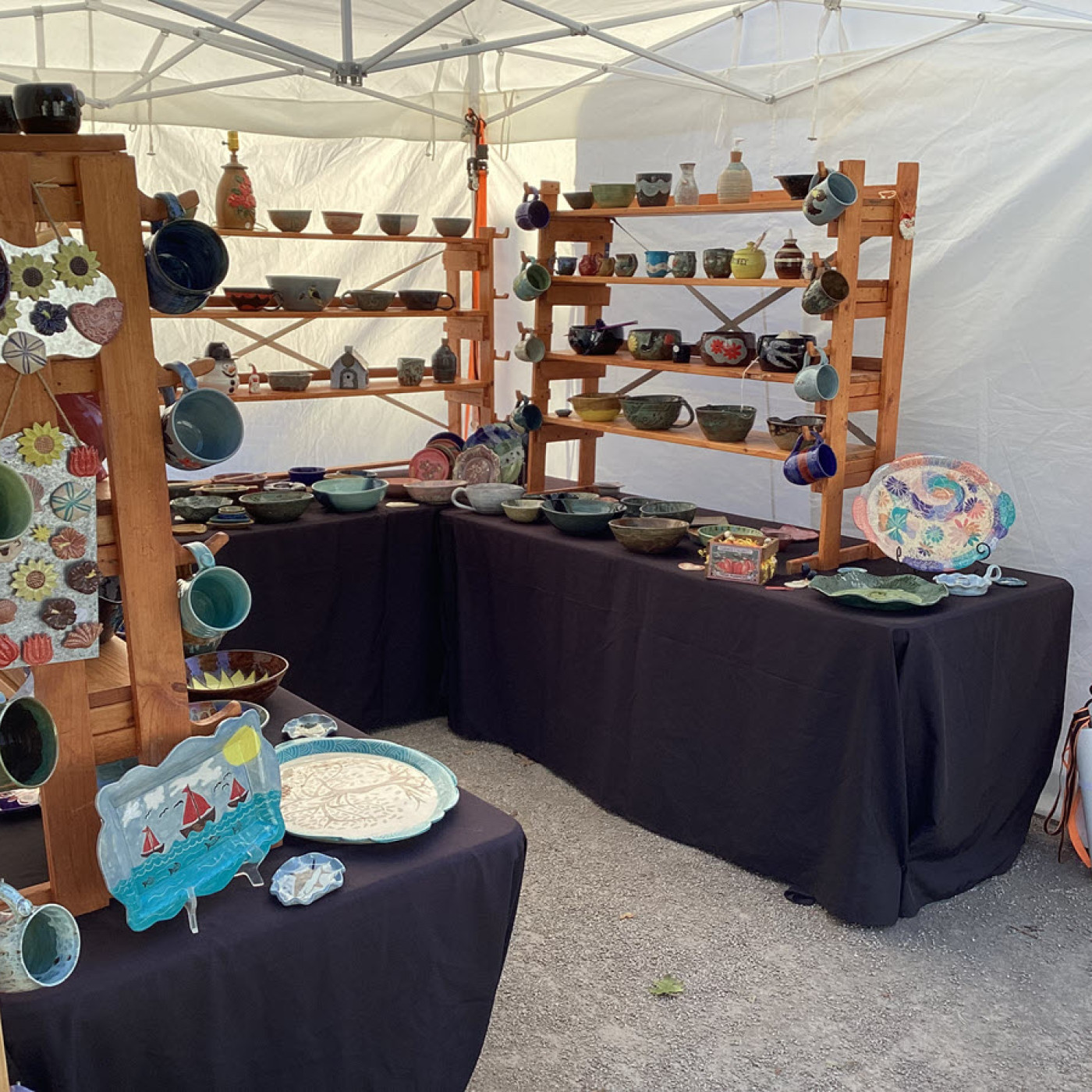
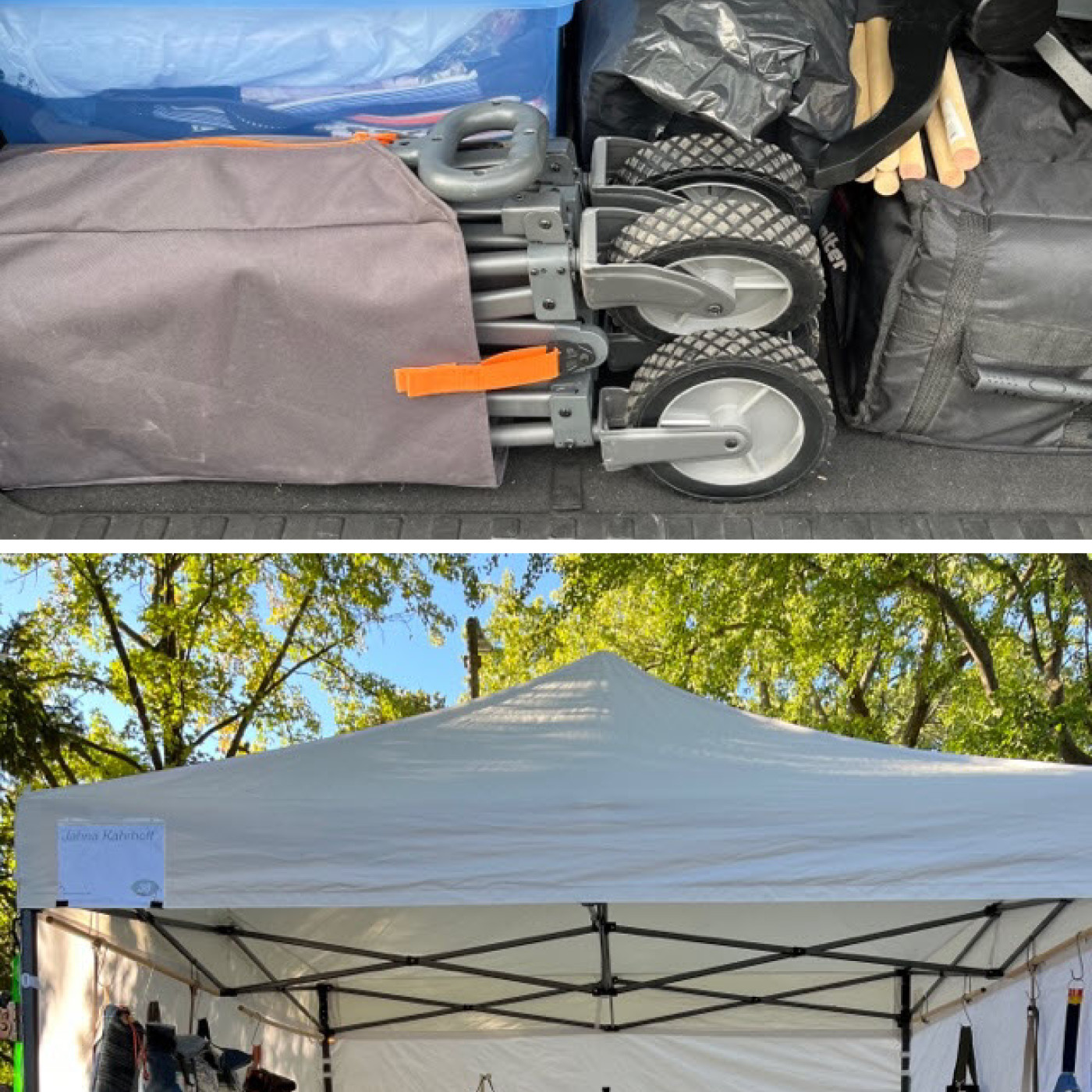
Packing Up Advice
Artists shared tips for the end of a show. “Take your time and pack up right. If you rush to get out first, traffic will be worse, and you stand a chance of damaging your own stuff by not packing up properly,” Wright said. “If you pack up when leaving as carefully as you pack up to arrive, you’ll know where everything is and be more than halfway ready for the next show.”
Kelsey rarely tries to get out early and notes there are often sales around then to “be backs” and stragglers. “For slower shows, we start putting away some of the smaller items first (to not attract attention),” she said. “By the time we are all packed up and ready to go, the street/area has emptied out and we aren’t in the mad dash to get out.”
Anything Kahrhoff no longer needs is taken home each night, so there is less to pack at the end. “Anything that can be taken down and packed the morning of the last day, such as lights that are no longer needed, helps things go more smoothly at the end of the day,” she said. “Also, having a specific order for packing my car is crucial. I know everything will fit — even if I’m in a hurry.”
Waters said, “Take a bit of extra time and think of it as packing for setup for the next show — put everything back in your storage containers and bags. Label your bags and boxes to speed up your packing. Bring a light/lantern for those days when sunlight might be fading during pack up.”
Zirinsky recommends eating something. “Some food and blood sugar provides energy and goes a long way toward getting packed. It won’t get packed by itself, so you are providing the energy to do that,” he said.
Glass artist Nancy Burke packs her work into specific bins that have the proper packing materials for her work. “Other artisans get out faster, so I have less competition for access when I’m ready to load-out,” she said.
Artists said consideration and kindness are important. “Wait until the show closes, as a courtesy to the show. Pack up your booth and gear and then bring your vehicle in to load. Don’t bring your vehicle in first to load as you break down,” Prescott said.
Szabo said the best advice a veteran artist gave her when she started was to keep notes or a journal for each show. “I often make notes throughout the show,” she said. “We also make a dedicated toolbox just for shows that has everything from extra zip ties to band-aids. Just remember to replace anything that runs out!”
